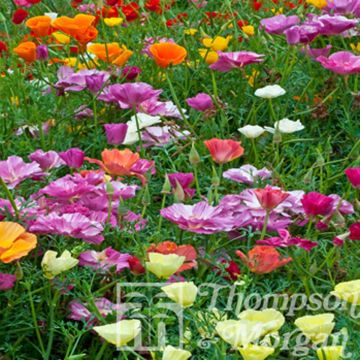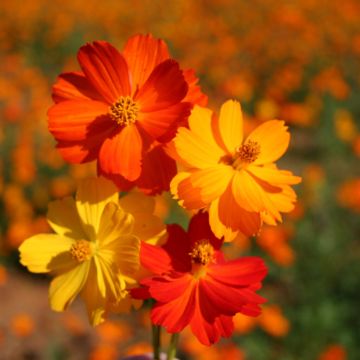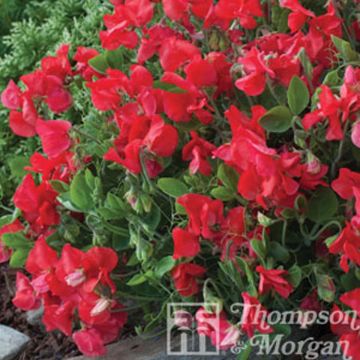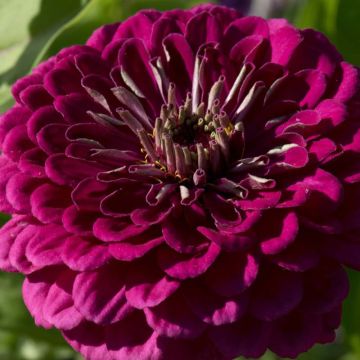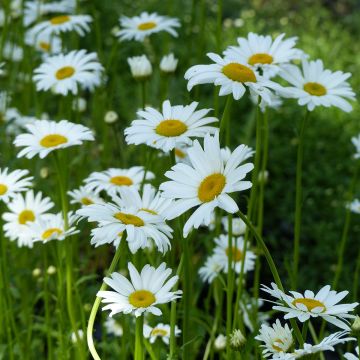

Rhodochiton atrosanguineus


Rhodochiton atrosanguineus
Rhodochiton atrosanguineus
Rhodochiton atrosanguineus
Purple Bell Vine, Purple Bellerine, Purple Bells
I wanted a pretty annual climber to provide shade over a reading corner, but the packet only contained a single seed. And they're already tiny as it is. I won't be able to tell you what it produces.
Christine, 10/08/2021
This item cannot be shipped to the selected country
Dispatch by letter from €3.90
More information
Schedule delivery date,
and select date in basket
This plant carries a 6 months recovery warranty
More information
We guarantee the quality of our plants for a full growing cycle, and will replace at our expense any plant that fails to recover under normal climatic and planting conditions.
Seed-only orders are dispatched by sealed envelope. The delivery charge for seed-only orders is €3.90.

Does this plant fit my garden?
Set up your Plantfit profile →
Description
Rhodochiton atrosanguineus is a lovely Mexican liana sometimes called "Purple Bell Vine" due to the shape of its flowers. Stretching over 2 metres (7 feet), its twining stems cling to any available support, such as trellises, tipis, or wire fences, using the petioles of its leaves transformed into tendrils. It tirelessly blooms from summer until early autumn, with long pendulous purple tubular flowers suspended from a beautiful violet calyx. It is a tender plant that can be grown as an annual and also in a conservatory during the winter. It will make a great impact in hanging baskets, cascading with flowers.
Rhodochiton atrosanguineus (synonym R. atrosanguineum) is a plant from the Plantaginaceae family, just like the climbing snapdragon (or lophospermum). It is native to Central America, specifically the southwest of Mexico, where it can be found on the edge of temperate rainforests. It is a herbaceous plant with a woody base, perennial from its stump, frost-tolerant (its stump can withstand up to -5°C (23°F)), but with very rapid growth: capable of reaching a height of 2.5m (8ft) in one season, it is often grown as an annual in temperate climates.
The stems of the 'Purple Bell Vine' bear heart-shaped, slightly hairy, light green leaves, often veined with purple. Flowering occurs from July to October. Hanging flowers, 4cm (2in) long, emerge from the leaf axils, suspended from long pinkish peduncles. Each flower consists of a calyx of pink-purple sepals, 2-3cm (1in) in diameter, bell-shaped, from which hangs a tubular corolla of dark violet that widens into 5 lobes. The centre of this corolla is occupied by white stamens. After pollination by insects, the flowers give way to fruits containing 3mm (0in) diameter seeds that easily germinate at 15-18°C (59-64.4°F).
Use the exotic and surprising Rhodochiton atrosanguineus, like the Asarina scandens, the Canary Creeper, or the Black-Eyed Susans, with which you can combine it on a wire fence, a small structure, as ground cover, or to decorate the terrace or balcony. It is entirely possible to keep this plant from year to year by growing it in a pot that you will overwinter protected from frost, in a bright space such as a conservatory or orangery.
Report an error about the product description
Plant habit
Flowering
Foliage
Botanical data
Rhodochiton
atrosanguineus
Scrophulariaceae
Purple Bell Vine, Purple Bellerine, Purple Bells
Central America
Planting and care
Sowing:
The seeds should be sown shallowly at a temperature of 15 to 20 °C. Cover the seedbed with a glass or plastic plate until the seeds germinate (between 10 and 40 days). Transplant the young plants into pots when they reach 5cm (2in) tall. They need a lot of light. You can move your pots outside or replant them directly in the garden once the risk of frost has passed. Plant your Purple Bell Vines, spacing them 50cm (20in) apart and ensuring that their collars are not buried.
Cultivation:
Rhodochiton thrives in rich, well-drained soils that remain moist in summer. It dislikes waterlogged or periodically dry soils. When planted in the ground, it can be placed in full sun or partial shade, sheltered from drafts and strong winds. When grown in a pot, choose a container with a minimum diameter and depth of 30cm (12in), and fill it with a mixture of 1/3 potting soil, 1/3 garden soil, and 1/3 sand. Make sure to water it regularly and provide it with flowering plant fertiliser every 15 days. Reduce watering in winter. If you overwinter your Rhodochiton in a dry environment, such as an unheated but poorly lit room (like a garage), it will lose its foliage but will still be able to regrow from the stump in spring.
Planting period
Intended location
Care
-
, onOrder confirmed
Reply from on Promesse de fleurs
Flower seeds
Haven't found what you were looking for?
Hardiness is the lowest winter temperature a plant can endure without suffering serious damage or even dying. However, hardiness is affected by location (a sheltered area, such as a patio), protection (winter cover) and soil type (hardiness is improved by well-drained soil).

Photo Sharing Terms & Conditions
In order to encourage gardeners to interact and share their experiences, Promesse de fleurs offers various media enabling content to be uploaded onto its Site - in particular via the ‘Photo sharing’ module.
The User agrees to refrain from:
- Posting any content that is illegal, prejudicial, insulting, racist, inciteful to hatred, revisionist, contrary to public decency, that infringes on privacy or on the privacy rights of third parties, in particular the publicity rights of persons and goods, intellectual property rights, or the right to privacy.
- Submitting content on behalf of a third party;
- Impersonate the identity of a third party and/or publish any personal information about a third party;
In general, the User undertakes to refrain from any unethical behaviour.
All Content (in particular text, comments, files, images, photos, videos, creative works, etc.), which may be subject to property or intellectual property rights, image or other private rights, shall remain the property of the User, subject to the limited rights granted by the terms of the licence granted by Promesse de fleurs as stated below. Users are at liberty to publish or not to publish such Content on the Site, notably via the ‘Photo Sharing’ facility, and accept that this Content shall be made public and freely accessible, notably on the Internet.
Users further acknowledge, undertake to have ,and guarantee that they hold all necessary rights and permissions to publish such material on the Site, in particular with regard to the legislation in force pertaining to any privacy, property, intellectual property, image, or contractual rights, or rights of any other nature. By publishing such Content on the Site, Users acknowledge accepting full liability as publishers of the Content within the meaning of the law, and grant Promesse de fleurs, free of charge, an inclusive, worldwide licence for the said Content for the entire duration of its publication, including all reproduction, representation, up/downloading, displaying, performing, transmission, and storage rights.
Users also grant permission for their name to be linked to the Content and accept that this link may not always be made available.
By engaging in posting material, Users consent to their Content becoming automatically accessible on the Internet, in particular on other sites and/or blogs and/or web pages of the Promesse de fleurs site, including in particular social pages and the Promesse de fleurs catalogue.
Users may secure the removal of entrusted content free of charge by issuing a simple request via our contact form.
The flowering period indicated on our website applies to countries and regions located in USDA zone 8 (France, the United Kingdom, Ireland, the Netherlands, etc.)
It will vary according to where you live:
- In zones 9 to 10 (Italy, Spain, Greece, etc.), flowering will occur about 2 to 4 weeks earlier.
- In zones 6 to 7 (Germany, Poland, Slovenia, and lower mountainous regions), flowering will be delayed by 2 to 3 weeks.
- In zone 5 (Central Europe, Scandinavia), blooming will be delayed by 3 to 5 weeks.
In temperate climates, pruning of spring-flowering shrubs (forsythia, spireas, etc.) should be done just after flowering.
Pruning of summer-flowering shrubs (Indian Lilac, Perovskia, etc.) can be done in winter or spring.
In cold regions as well as with frost-sensitive plants, avoid pruning too early when severe frosts may still occur.
The planting period indicated on our website applies to countries and regions located in USDA zone 8 (France, United Kingdom, Ireland, Netherlands).
It will vary according to where you live:
- In Mediterranean zones (Marseille, Madrid, Milan, etc.), autumn and winter are the best planting periods.
- In continental zones (Strasbourg, Munich, Vienna, etc.), delay planting by 2 to 3 weeks in spring and bring it forward by 2 to 4 weeks in autumn.
- In mountainous regions (the Alps, Pyrenees, Carpathians, etc.), it is best to plant in late spring (May-June) or late summer (August-September).
The harvesting period indicated on our website applies to countries and regions in USDA zone 8 (France, England, Ireland, the Netherlands).
In colder areas (Scandinavia, Poland, Austria...) fruit and vegetable harvests are likely to be delayed by 3-4 weeks.
In warmer areas (Italy, Spain, Greece, etc.), harvesting will probably take place earlier, depending on weather conditions.
The sowing periods indicated on our website apply to countries and regions within USDA Zone 8 (France, UK, Ireland, Netherlands).
In colder areas (Scandinavia, Poland, Austria...), delay any outdoor sowing by 3-4 weeks, or sow under glass.
In warmer climes (Italy, Spain, Greece, etc.), bring outdoor sowing forward by a few weeks.




































